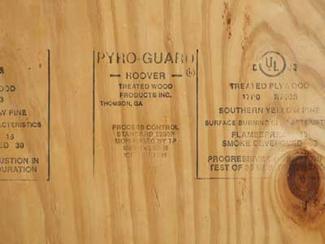Fire Retardant Treated (FRT) Wood Meets Code, Reduces Cost and Saves Lives
By Nick Rollo
First, let’s define fire retardant. It’s important to understand the difference between fire-resistant materials versus fire retardant materials. Fire resistant materials are designed to both withstand heat and resist burning. Fire retardant materials, on the other hand, are designed to burn slowly by reducing the spread of fire and smoke and delaying combustion.
Fire Retardant Treated Wood is impregnated with chemicals deep into the wood by a pressure process or other means during manufacturing and results in a flame spread number of 25 or less and shows no evidence of significant combustion when the test is continued for 20 minutes.


These materials are often referred to as Fire Treated Lumber. When you’re installing or ordering Fire Treated material, it’s important to know what, exactly, you need. In the case of both plywood and lumber, these building materials become fire retardant with the application of a chemical substance that slows down the process of oxidation when a fire occurs. It can be used for both interior and exterior. At Outpost, the vast majority of our sales are Class A fire treated, but it’s always best to be sure you’re meeting your specifications.
When deciding what wood to use, it’s important to know the class assigned to it based on its flame spread to know if it qualifies as noncombustible or a noncombustible substitute.
Class |
Flame Spread |
Noncombustible |
0 |
Class A |
0-25 |
Class B |
26-75 |
Class C |
76-200 |
FRT Wood must have a Class A rating to be considered a noncombustible substitute.
Sometimes the answer to whether to use FRT Wood or not is as simple as “Yes because the code requires it”. Always be sure to refer to your local code and building inspection requirements first, but in general, the International Building Code (IBC) allows for FRT to be used when noncombustible materials are required. This is typical for Type III and Type IV construction.
So, yes, not only does FRT help meet code requirements in a cost-effective manner when applicable, but it also has many other ancillary benefits as well, including:
• Allows safety crews more time to get a fire under control and contained
• Allows more time for occupants of the building to safely exit
• Chemical treatment also typically protects wood from termites and fungal decay
• Fire damage and repair costs are often minimized
• Insurance rates/claims can be reduced as a result of its use
